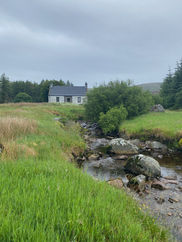Citizen Science
Actively involving people in Water Cycle: a multi-disciplinary Water Quality Research Project
Peatland Connections put out an open call on social media platforms "Water Cycle: A Call to Intrepid Explorers on Wheels."
The call, to participate in water quality research, was an invitation to cyclists willing to rise to the challenge of a venture to cycle eleven miles along an active forestry track - in places thick with peat and mud, furrowed, and potholed - up the Upper Blackwater of Dee catchment and back down again to collect water samples from the water courses running through the modified landscape of (predominantly) Sitka afforestation and clear-fell, healthy peatland including the Ramsar site, Silver Flowe, and peatland restoration sites (from forest to bog).
The Upper Blackwater of Dee catchment is a peat dominated landscape situated in a remote area of Galloway at the heart of the Galloway and Southern Ayrshire UNESCO Biosphere. It is a challenging landscape and only publicly accessible on foot or by bicycle. Given the distance to be covered to collect water samples, the only viable way to involve the public was to develop a citizen science project for off road cyclists.
Galloway is a great place for outdoor recreation, including cycling. National Cycle Route 7 traverses along the Upper Blackwater of Dee, a route likely to appeal to people who have an interest in the outdoors, endurance activities, and aerobic exercise.
Taking advantage of National Cycle Route 7 we openly invited cyclists to Join us, full stream ahead along the gravel track to feel the burn and:
-
Collect water samples at eight of the seventeen sample sites,
-
Discover more about the landscape, for example, landscape use, Natural Capital, nature-based solutions, biodiversity and conservation, landscape restoration, and peat,
-
Ask us questions,
-
Engage in conversations triggered by the research project and this landscape,
and,
-
At the end of the uphill route, with water samples in the bag, join us for lunch, hot drinks, and a blether at the Backhill of Bush Bothy before sonde analysing the water samples and heading back down the track.
People accustomed to off road cycling through challenging landscapes, regardless of the weather, proved to be perfect participants because, along with the action of collecting water samples, which requires physical fitness and stamina, they brought with them outdoor experiences and stories. Sharing experiences connected to the ever-shifting landscape changes in the region and exchanging anecdotal observations potentially connected Climate Change was as an important element of this project as collecting the samples. As a cohort, we leant together as knowledge was shared. Our collective understanding of this landscape, water quality concerns, and connectedness to the outdoors and nature grew. As one participant put it:
This is a bike ride with a purpose.
Another said:
Knowing more about this landscape and fact that much of it is peat, and leaning about peat, has changed the way I see Galloway and think about land use.
To generate robust results and meaningful baseline data, it was important to collect water samples during periods of heavy rainfall when low pH pulses are most likely to occur, or in hot, drought conditions when water temperature is likely to increase. However, with a citizen science approach, events need to be programmed and advertised in advance. Whatever the weather, we set off on our venture. It turned out that, from a human point of view, we were lucky with the weather; we didn’t experience any deluge or extreme heat. However, collecting data generated under more extreme weather conditions was necessary, prompting impromptu treks when the weather turned to collect water samples.
In total, 95 water samples were collected and analysed.
Thank you to all the intrepid citizen science off road cyclists who made this research project such a rich and enjoyable experience.


























